Animal identification and other documents required
We have a list of pre-approved training organisations and assistance animal passes that we accept. If you hold an assistance animal pass issued by one of these organisations or as listed below, that is all you need to provide to travel with your assistance animal.
Queensland Rail Travel will accept documentation and passes for assistance animals that are issued by any of the below:
- Approved trainers and training institutions | People with disability | Queensland Government (www.qld.gov.au) (opens in new tab).
-
Translink (see note below) (opens in new tab)
-
Transport for NSW (opens in new tab)
-
Victorian Public Transport (opens in new tab)
-
Government of WA (opens in new tab)
-
Young Diggers (opens in new tab)
-
Revolutionary Assistance Dogs Inc (opens in new tab)
-
mindDog Australia (opens in new tab)
Queensland Rail Travel will also accept passes for assistance animals issued by organisations accredited or recognised by any of the below:
-
Assistance Dogs International (opens in new tab)
-
ACT Government Domestic Animals Act 2000 (opens in new tab)
-
South Australian Dog and Cat Management Board (opens in new tab)
-
Western Australian Government Dog Act 1976 (opens in new tab)
Note: To obtain a
Translink Assistance Animal Pass, in addition to a health professional declaration and a veterinary declaration, an applicant may provide a training declaration from a professional training organisation/individual, or an applicant may provide a training declaration if the animal is trained by the applicant or another individual. The
Translink application form states to allow up to 15 working days for the application to be processed, this time period should be considered when planning your travel with us.
Queensland Rail Travel will consider passes issued by other organisations that deliver appropriate training but are not on the above lists and links. To enable us to confirm training, we may require documentation, or request information about your training organisation. Please let us know at the time of booking if you do not hold a pass from an approved trainer or training institution as listed above.
In the absence of evidence or identification, travel with the assistance animal may not be approved. If you are unable to provide sufficient evidence that the assistance animal has been trained, please discuss with us in advance of travel.
Sample images of identification for handlers/trainers
The following images of cards issued by the Queensland Government for handlers and trainers of guide, hearing and assistance dogs will be accepted by Queensland Rail Travel.
).jpg)
Translink Assistance Animal Pass dog (front)
.jpg)
Translink Assistance Animal Pass dog (back)
).jpg)
Translink Assistance Animal Pass cat (front)
.jpg)
Translink Assistance Animal Pass cat (back)
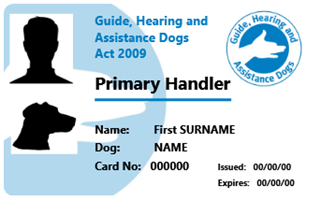
Primary Handler Identification
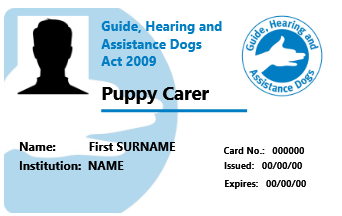
Puppy Carer Identification
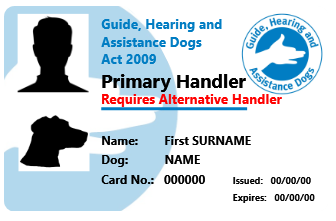
Primary Handler Identification (requires alternate handler)
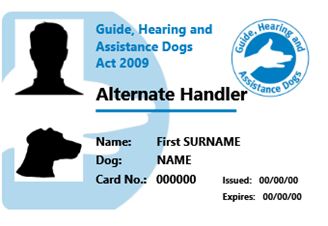
Alternate Handler Identification
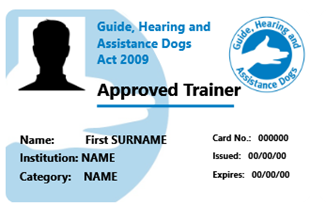
Approved Trainer Identification
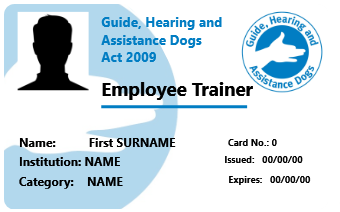
Employee Trainer Identification
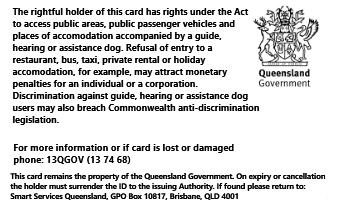
Identification back of card
Images of identification for animals
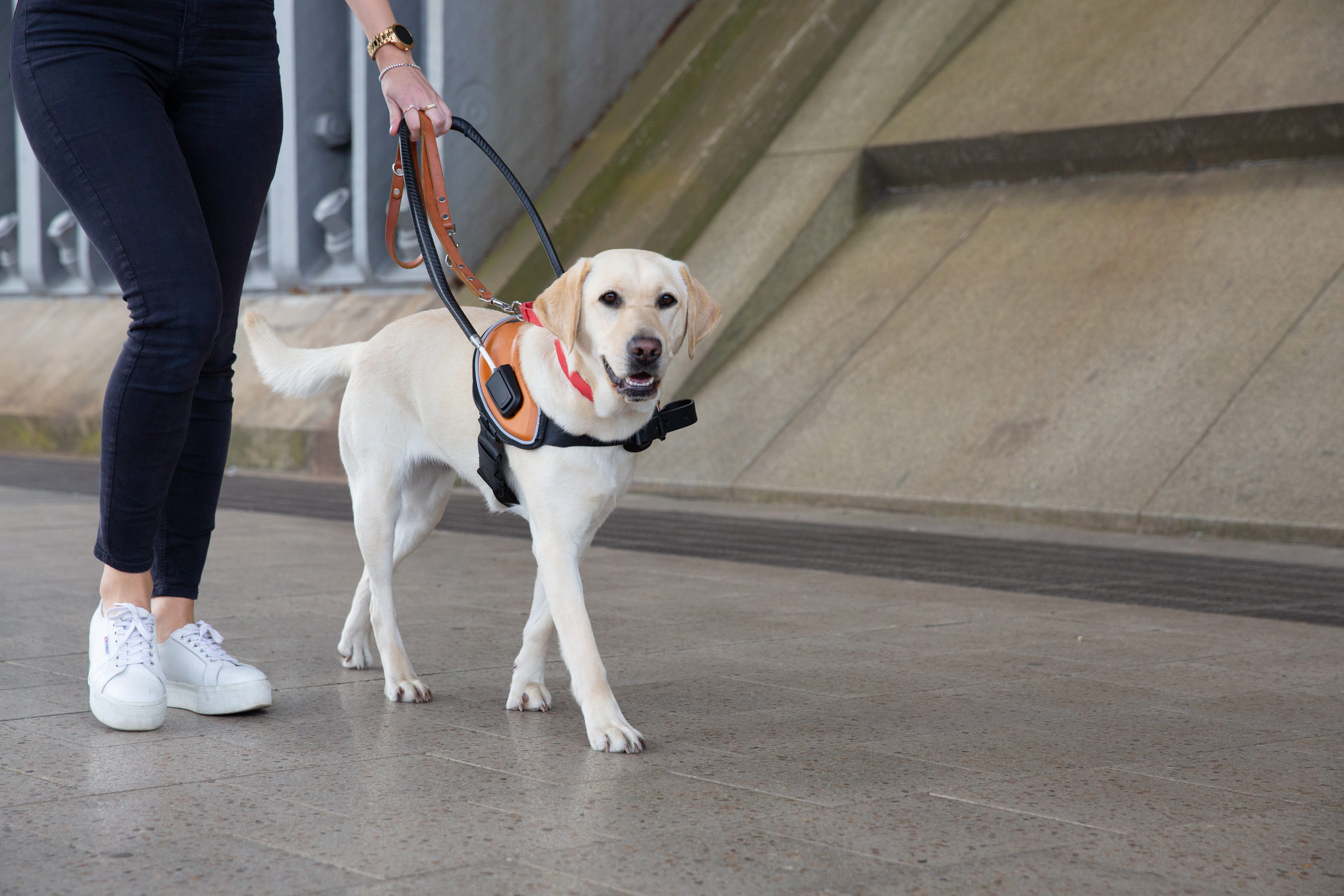
A Guide Dog walking with a harness
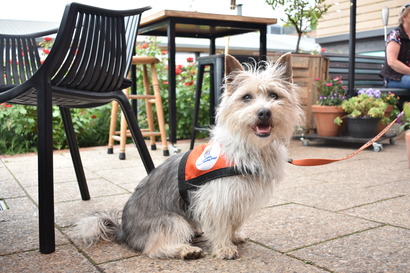
A Lions Hearing Dog wearing an identifying coat and lead
Handler/Trainer responsibilities while travelling with us
Handler/Trainer responsibilities:
- To carry sufficient evidence that the assistance animal has been trained, including handler or trainer identification. This may include a Translink Assistance Animal pass.
- Trainers and handlers must display their identity card on request.
- Ensure your assistance animal wears their identification badge/medallion, coat, vest or harness if:
- an identification badge/medallion, coat, vest or harness has been issued to your assistance animal as part their training; or
- an identification badge/medallion, coat, vest or harness is required by a law of a State or Territory that provides for the accreditation of assistance animals (for example, dogs certified under the Guide, Hearing and Assistance Dogs Act 2009 (Qld) are required to wear an identifying coat).
- To ensure the assistance animal is under the direct control of the handler or a trainer at all times, this includes taking the assistance animal off the train for comfort stops.
- For their safety, the assistance animal must be seated on the floor in the space allocated by Queensland Rail Travel and not on an adjacent seat or in the lap of the handler/trainer or impeding the aisle way.
- To ensure the good behaviour and hygiene of the assistance animal.
- It is recommended that you supply absorbent bedding or a mat suitable for your assistance animal that is clean and in good condition.
- If a carrier is being used for the assistance animal, this must also be clean and in good condition.
- Customers must account for any damage to Queensland Rail Travel property by the assistance animal.
- Discuss with the onboard team regarding your dining options and any aspects of your journey.
Comfort stops for assistance animals:
Information for planning comfort stops for your assistance animal can be sourced by checking our
timetables for stops on your journey with longer durations.
Once on the train, we recommend you discuss with the onboard team for information about suitable locations for comfort stops for your assistance animal on your particular service departure.
How to make a booking including an assistance animal
How to make a booking that includes an assistance animal:
Bookings are required when travelling with assistance animals. They will be carried free of charge on Queensland Rail Travel services.
Bookings can be made online, over the phone or in person at a or in person at a Travel Centre, ticket office or travel agent.
Our booking system has been setup with locations on each train and in each travel option that provides space for your assistance animal. For details on these locations on each service, please visit
Carriage Layouts.
In general, these locations on each train are as close as possible to the carriage exit doors to enable easy access for the customer and their assistance animal.
The seating configuration for you and your assistance animal may change depending on the service and carriage:
Bookings in a Seat or RailBed:
- A seat or RailBed will be booked where there is adjacent floor space provided to comfortably accommodate the assistance animal.
- An extra seat or RailBed will be held (free of charge) in some locations next to the person travelling to allow for the assistance animal to sit on the floor in front of the extra seat or RailBed.
Bookings in a Sleeper:
- When booking a Sleeper, a Twin Sleeper will be held to provide floor space to comfortably accommodate the assistance animal.
If these designated locations are not available or you require a different allocation, please contact us to discuss other options.
When making a booking of this type, the travel option you require should state “includes assistance animal space”.
At the time of booking, you are required to provide the assistance animal pass type (e.g. Translink Assistance Animal Pass) or details of the training institution (e.g.
Approved trainers and training institutions | People with disability | Queensland Government (opens in new tab)).
We may need to contact you if the pass or training institution is not one that we currently accept. Refer to the tab in the menu above this section:
Animal identification and other documents required.
You must provide the above information to us for every booking, as this information is not automated to be added to new bookings.
Bookings can be made in the following ways: